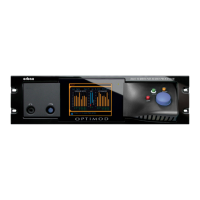OPTIMOD SURROUND PROCESSOR INSTALLATION
2-17
use a GPI input to trigger preset changes, modify presets to customize
your sound, and store these presets as User Presets.
Preset names are just suggestions. Feel free to audition different presets
and to choose those whose sound you prefer.
You can easily modify a preset later with the 8685’s one-knob L
ESS-MORE
feature. Refer to Section 3.
If you want the 8685’s surround and 2.0 processors to operate with dif-
ferent presets, import a 2.0 preset into the active preset and save the
combination as a User Preset. Instructions for importing and editing a 2.0
preset are on page 3-25. Note that while the 2.0 and surround processors
can use different presets, all 2.0 processors must use the same preset.
Congratulations! You are now transmitting with your initial sound.
Feel free to
read the material in Section 3 of this manual, which describes the various presets
and how you can customize them to achieve your desired signature sound.
Presets and Loudness: All 8685 TVxxxx presets are designed to produce
very similar loudness with speech and to do so regardless of the setting
of their L
ESS-MORE controls. Our goal was to allow these presets to be
used on-air without need for loudness adjustment, assuming that you
have told the 8685 what D
IALNORM value you are transmitting to the con-
sumer. We set loudness partly by making appropriate compression
threshold and limiter drive adjustments, and partly by using the 8685’s
Loudness Controller.
Note that TVxxxx presets are designed for digital television. Do not con-
fuse these with the TVAxxxx presets, which should be used only when the
8685’s 2.0 processing is driving an analog television transmitter. (See step
11 on page 2-31 for instructions on how to c
onfigure your 8685 for ana-
log TV.)
We tuned the “Radio” presets to produce loudness that is approximately
the same as the TVxxxx presets. Unlike other Optimods, L
ESS-MORE ad-
justments have minimal effect on loudness and mainly set the amount of
compression. Because the 8685’s loudness controller is defeated in the
“Radio” presets, loudness will not be as consistent from source to source
as it is with the TVxxxx presets.
You can use the 8685’s loudness controller to improve the loudness con-
sistency of a “Radio” preset. First, adjust the preset with L
ESS-MORE to
achieve the desired processing texture. Then activate the loudness con-
troller by setting the preset’s L
OUDNESS THRESHOLD control to –10 dB,
which matches the loudness controller’s threshold to the active D
IALNORM
value. For the best tradeoff between consistent loudness and potential
artifacts, adjust the MB L
IMITER DRIVE control so that the loudness control-
ler’s gain reduction meter typically indicates 3 dB. You should see the
Loudness Level meter peaking around at 0 dB. When you have finished
your adjustments, save the result as a User Preset.
See also Setting Preset Loudness Correctly for Dolby Digital Transmission
on page 3-19.
This concludes the guided Quick Setup procedure. However, you may wish to set up
some other 8685 features. These are described in the following optional steps.

